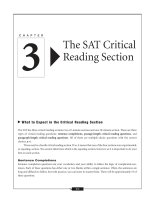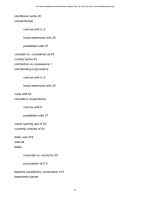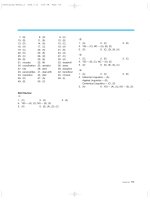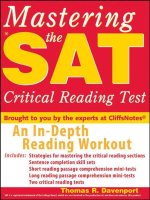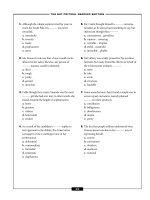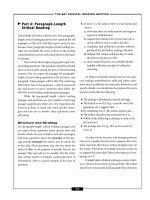The sat critical reading section 7 ppt
Bạn đang xem bản rút gọn của tài liệu. Xem và tải ngay bản đầy đủ của tài liệu tại đây (70.62 KB, 6 trang )
Questions 33–40 are based on the following passage.
The following excerpt from Charles Darwin’s The Voyage of the Beagle tells of a defining chapter in the life of a budding
scientist.
The voyage of the “Beagle” has been by far the most important event in my life, and has determined my
whole career; yet it depended on so small a circumstance as my uncle offering to drive me thirty miles to
Shrewsbury, which few uncles would have done, and on such a trifle as the shape of my nose. I have always
felt that I owe to the voyage the first real training or education of my mind; I was led to attend closely to
several branches of natural history, and thus my powers of observation were improved, though they were
always fairly developed.
The investigation of the geology of all the places visited was far more important, as reasoning here
comes into play. On first examining a new district nothing can appear more hopeless than the chaos of rocks;
but by recording the stratification and nature of the rocks and fossils at many points, always reasoning and
predicting what will be found elsewhere, light soon begins to dawn on the district, and the structure of the
whole becomes more or less intelligible. I had brought with me the first volume of Lyell’s Principles of Geol-
ogy, which I studied attentively; and the book was of the highest service to me in many ways. The very first
place which I examined, namely St. Jago in the Cape de Verde islands, showed me clearly the wonderful
superiority of Lyell’s manner of treating geology, compared with that of any other author, whose works I
had with me or ever afterwards read. Another of my occupations was collecting animals of all classes, briefly
describing and roughly dissecting many of the marine ones; but from not being able to draw, and from
not having sufficient anatomical knowledge, a great pile of manuscripts which I made during the voyage
has proved almost useless. I thus lost much time, with the exception of that spent in acquiring some knowl-
edge of the Crustaceans, as this was of service when in after years I undertook a monograph of the
Cirripedia.
During some part of the day I wrote my journal, and took much pains in describing carefully and
vividly all that I had seen; and this was good practice. My journal served also, in part, as letters to my home,
and portions were sent to England whenever there was an opportunity.
The above various special studies were, however, of no importance compared with the habit of ener-
getic industry and of concentrated attention to whatever I was engaged in, which I then acquired. Every-
thing about which I thought or read was made to bear directly on what I had seen or was likely to see; and
this habit of mind was continued during the five years of the voyage. I feel sure that it was this training which
has enabled me to do whatever I have done in science.
Looking backwards, I can now perceive how my love for science gradually preponderated over every
other taste.
–THE SAT CRITICAL READING SECTION–
72
Line
(5)
(10)
(15)
(20)
(25)
(30)
5658 SAT2006[03](fin).qx 11/21/05 6:42 PM Page 72
33. In line 4, when the author speaks of the first real
training or education of my mind, he refers to
a. the voyage of the Beagle
b. the development of his career
c. the branches of natural history
d. his powers of observation
e. the shape of his nose
34. In line 7, the author says he considers geology far
more important due to the fact that
a. its structure is obvious
b. it helped him learn to reason
c. he made sense out of chaos
d. play is as important as work
e. he learned how to study
35. In line 9, the word stratification most nearly
means
a. coloration
b. calcification
c. layers
d. composition
e. location
36. In lines 10–11, the phrase the structure of the
whole becomes more or less intelligible refers to
a. the break of day
b. the ability to predict findings
c. a comprehensive knowledge
d. the assurance of correctness
e. the fitting together of disparate facts
37. In line 18, the admission that many of the
author’s manuscripts proved almost useless
depends on the notion that
a. it is necessary to draw and know anatomy
when collecting animals
b. additional description would have been
required for clarity
c. a rough dissection is better than no dissection
d. publication requires more finesse than he
possessed
e. describing and dissection are a waste of time
38. In line 19, the word monograph most nearly
means
a. a line drawing
b. a comprehensive treatment
c. a one-page summary
d. a thorough dissection
e. a written treatment
39. In lines 21–23, the author sees the primary value
of his journal as being
a. a contribution to English society
b. good preparation for his future work
c.
practice in painstaking description
d. killing two birds with one stone
e. to serve as letters home
40. In lines 24–25, the author is saying that
a. the study of geology is not as interesting as he
had hoped
b. learning about Crustaceans was tedious
c. his studies on the Beagle turned out to be
unimportant
d. the studies were not as important as acquiring
systematic study habits
e. acquiring good study habits was the best part
of his trip
–THE SAT CRITICAL READING SECTION–
73
5658 SAT2006[03](fin).qx 11/21/05 6:42 PM Page 73
Long-Passage Critical Reading
Answers
1. b. A countenance is a face and/or its expression.
Therefore, a shadowed countenance is a somber
face. In lines 4–5, a clue is given when the
author contrasts the Señora’s shadowed coun-
tenance with Ramona’s face.
2. c. Lines 9–10 contain the answer to this ques-
tion. She had promised to be a mother to her is
the applicable phrase.
3. b. Staunchness is the quality of being steadfast or
firm. Inalienable means not able to be
changed. She fulfilled the letter of her promise
in line 10 is a contextual clue to the answer.
4. e. In lines 11–19, the author gives several reasons
Ramona’s story was seldom told. Don’t be dis-
tracted by answer choices that refer to reasons
other than they would have tragedies enough of
their own presently. That phrase means that
enough sadness will come into the young peo-
ple’s lives soon, so there’s no need to sadden
them with this story.
5. b. Bereft of his senses in line 25 is a phrase that
uses the word senses to mean sanity. Bereft
means to be without, especially to be deprived
of. It is important in this sentence of the pas-
sage to notice that the author says he was like
someone bereft of his senses. The phrase madly
in love which precedes the phrase in question
is your clue to the meaning of the expression
bereft of his senses.
6. e. The author relates that Ramona Gonzaga for
months told Angus she didn’t love him and
couldn’t marry him, but that she finally gave
in, due to his stormy and ceaseless entreaties
(lines 27–28). That was the only excuse ever
to be made for Ramona Gonzaga’s deed
(lines 25–26).
7. d. The fact that Ramona turned away long before
Angus did as their ships sailed apart (lines
36–37) indicates that he loved her more than
she loved him.
8. d. The author talks about this vital principle that
gives life to everything for a whole paragraph
(lines 1–6), using the pronoun it to refer to the
original statement about early habits of
observation.
9. a. The paragraph in which this reference is
found (lines 7–13) relates in detail what the
farmer observed and what he did. He trans-
planted the wild vine and pruned it, to repli-
cate what the oxen did.
10. c. The author states that, after pruning, all the
nourishment went entirely to the body of the
grape (lines 11–12).
11. e. Luxuriance means abundance or richness. The
word extreme, which modifies luxuriance
,as
well as the fact that the author is talking about
the vines in a positive light, are clues to the
word’s meaning.
12. e. The author is building upon the necessity for
good observation by discussing how to apply
observation to everyday life. The sentence that
addresses the question is She should use her
thoughts in all her employments (lines 26–27).
13. b. A synonym for peculiar is distinctive. It is the
meaning intended by the author, and the only
word that fits as a substitute for peculiar.
14. b. Trifling means unimportant. Your context clue
is the word however in line 27. An occupation,
in this sense, is whatever one is doing.
15. e. Punctuation is the key to deciphering this
complex sentence. Tracing backward from the
word reality (line 34), you discover that it is
opinion, and prejudice, and tradition, and
delusion, and appearance (lines 31–32) that
prevent our getting at reality.
–THE SAT CRITICAL READING SECTION–
74
5658 SAT2006[03](fin).qx 11/21/05 6:42 PM Page 74
16. c. Lines 31–34 provide a big clue here. The
author makes a very long list to make the
point that delusion and prejudice is pervasive
everywhere.
17. a. There is no one phrase or sentence that
reveals the author’s meaning in this para-
graph. He is writing about the mind, or the
intellect. Your best clue is in line 48 where
the author says My head is hands and feet.
18. b. The author of the first passage writes about
the importance of observing what is in front
of you, even though many won’t see it. The
second author also writes about using your
mind to see what is real.
19. d. While both authors offer advice, after a fash-
ion, the approach of author 1 is practical,
while author 2 is more intellectual and
abstract in his advice.
20. a. Both authors value thinking for oneself.
21. e. You can see that the author of this passage is
sympathetic to the Hawaiians’ culture. She is
defending against the claim that the chiefs
exploited their followers.
22. a. Sustenance refers most often to food, but in
this context (line 7), it includes all kinds of
material support.
23. c. Forests furnished the materials for the tapa
cloth, and it was the forests which were given
to the women (lines 12–13).
24. e. The author uses the homeless condition of
present-day (at the time of her writing)
Hawaiians as a contrast to the lack of home-
lessness under the traditional system. (lines
13–17). She offers this as evidence of the tra-
ditional system’s superiority.
25. d. You have to read this entire paragraph to dis-
cover that the reason the author offers for the
adoption custom is that it cemented the ties of
friendship (line 32) among the chiefs and the
common people.
26. b. The author feels that her people’s traditional
customs need defending against assaults from
foreigners. Lines 1–2 set the tone for the entire
passage.
27. b. By age, the author means era. In lines 1–2, he
states, “ each period ofculture produces an
art of its own ,”which helps explain what
he means by Every work of art is the child of its
age in line 1.
28. c. The author is drawing a parallel between
humans imitating art and monkeys imitating
the behavior of humans. He does this to prove
that replicating art is empty and mechanical,
as is a monkey pretending to be human.
29. e. Presentiment refers to the feeling that some-
thing is about to occur, or premonition.
30. d. In paragraph 3, the author describes how and
why doubt and materialism are present in
society. Lines 23–24 say, “For this reason, the
Primitive phase . . . can only be of short dura-
tion”; “this reason” refers to the prevalence of
doubt and materialism. Although the author
does say that the human soul is cracked like a
vase (choice a), this is the result of human
doubt and despair—the true cause of a short-
lived Primitive phase. The author also men-
tions choice b in paragraph 3, but again, this is
a symptom of the greater issue: the prevalence
of fear and doubt. Choice c is incorrect; the
author never says this is the case, but rather
that humans consider it as a possibility when
in doubt. Choice e is incorrect, as the author
never mentions this as a possibility.
31. c. The author is extremely passionate about this,
and the passage provides many clues to
demonstrate this. For instance, in paragraph
3, the author refers to materialism as a “night-
mare.” In line 37, he says that when art fulfils it
purpose, it feeds the spirit. The author never
implies any of the possibilities offered by
choices a,
b, d,or e.
–THE SAT CRITICAL READING SECTION–
75
5658 SAT2006[03](fin).qx 11/21/05 6:42 PM Page 75
32. a. The definition of diametrically is “opposite”;
thus, unalike is best choice.
33. d. It was the training in several branches of natu-
ral history that led to the improvement of the
author’s powers of observation (lines 4–6).
34. b. The author says the investigation of geology
brought reasoning into play (lines 7–8),
meaning he had to develop his reasoning.
35. c. Stratification means layers. In lines 8–11, strat-
ification is opposed to chaos, as the way in
which rocks are ordered.
36. e. As the author works through the logic of geol-
ogy, the many disparate facts begin to make
sense (lines 9–11).
37. a. The author says that the facts that he was not
able to draw and did not have sufficient
anatomical knowledge (lines 16–18) made his
manuscripts worthless.
38. e. Monograph is a word for a narrowly focused
written treatment of a subject. Compare
monograph (line 19) with manuscripts (line
17) for your context clue. In the context, a
monograph could not be less thorough than a
manuscript.
39. c. The author says he took much pains in describ-
ing carefully and vividly, and that this was good
practice (lines 21–22).
40. d. Although they do mention “special studies,”
lines 24–25 do not say that geology was not as
interesting as the author had hoped (choice a),
or that the study of Crustaceans was tedious
(choice b). Although Darwin does say that the
studies themselves were not as important as
the skills he acquired, he does not imply that
his studies on the Beagle turned out to be
unimportant (choice c)—on the contrary.
Again, although Darwin does indeed state that
the studies were secondary to the skills he
acquired, he does not say that acquiring these
skills was the best part of his trip, making
choice e incorrect.
–THE SAT CRITICAL READING SECTION–
76
5658 SAT2006[03](fin).qx 11/21/05 6:42 PM Page 76
Part 3: Paragraph-Length
Critical Reading
Out with the old and in with the new: New paragraph-
length critical reading questions have replaced the old
analogies on the SAT. And that’s good news for you,
because these paragraph-length critical reading pas-
sages are essentially the same as those in the reading
comprehension section, only much shorter and easier
to manage.
The SAT has about eight paragraph-length criti-
cal reading questions. The questions should be divided
more or less equally among the three Critical Reading
sections. You can expect the passages for paragraph-
length critical reading questions to be just that—one
paragraph. Most passages will be 100–350 words long
followed by two to five questions—a sharp contrast to
the half-dozen or more questions that follow the
400–850-word reading comprehension passages.
While the paragraph-length critical reading
passages and questions are very similar to their long
passage counterparts, there are a few important dif-
ferences to keep in mind and some specific strate-
gies you can use to answer these questions more
effectively.
Structure and Strategy
For paragraph-length critical reading passages, you
can expect fewer questions about specific facts and
details (which are easy to find in such short passages)
and more questions about the structure of the pas-
sage and the strategies the author uses to convey his
or her idea. These questions may ask you about the
order of ideas or the purpose of specific lines in the
passage. They may ask you to consider why the writer
uses certain words or includes a particular piece of
information. Here is a good example of this type of
question:
1. In lines 1–2, the author refers to a list of pros and
cons to
a. show that there are both positive and negative
aspects of utilitarianism
b. suggest that making a list of pros and cons is
not an effective way to make a decision
c. emphasize that utilitarians consider both the
good and the bad before making a decision
d. indicate that readers will learn how to make
decisions using pro/con lists
e. show readers that they are probably already
familiar with the principles of utilitarian
reasoning
So while you should continue to hone your gen-
eral reading comprehension skills and expect ques-
tions about vocabulary, the main idea, inferences, and
specific details, you should also be prepared for more
question stems like the following:
■
The passage is developed primarily through . . .
■
The author’s use of X (e.g., a specific word, list,
quotation, etc.) suggests that . . .
■
By comparing X to Y, the author implies that . . .
■
The author describes/presents/refers to X to
■
Which of the following techniques is used in the
last sentence?
■
The passage uses X (e.g., first-person point of
view) to . . .
In other words, structure and strategy questions
ask you to consider how the writer expresses his or her
ideas and what effect those writing strategies have on
the reader. What kind of examples does the writer use
to support the main idea? What is the impact of com-
paring X to Y?
It might help to think of writing as a series of deci-
sions. Writers choose their words carefully. They think
about how to punctuate and paragraph their sentences
77
–THE SAT CRITICAL READING SECTION–
5658 SAT2006[03](fin).qx 11/21/05 6:42 PM Page 77
